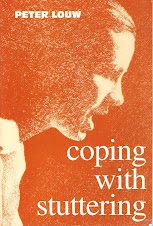Dr Martin Schwartz has been so generous as to make his 2008 DVD-based Self-therapy Course for People who Stutter available to the general public for free, and it gives me great pleasure to present the course here on my blog. Much thanks to Dr Schwartz for this great gesture.
The course consists of three videos plus a manual and a workbook. Note that Dr Schwartz also highly recommends that you acquire the MotivAider, an electronic appliance that will remind you to use your speech technique.
Video 1, titled The Understanding, explains why people stutter. What we see and hear as "stuttering", is merely struggle behaviour resulting from the vocal cords that have "locked" due to excessive tension on the cords. Here is video 1: (If you have a mobile phone or tablet, or have problems in viewing the video, watch it on YouTube HERE )
But what can we do about this vocal-cord lock? Video 2 is all about treating the cord lock, not the stutter itself. When we reduce the tension on the vocal cords, we lower the possibility that they will lock (and cause a stutter). In video 2, the Slowed First Syllable technique is explained - the first of various techniques to reduce pre-speech tension on the vocal cords. Herewith video 2: (View it HERE on YouTube if you have a mobile appliance or are unable to open the video.)
In the third video, Dr Schwartz discusses another powerful technique to reduce vocal-cord tension: the Passive Airflow Technique: (View it HERE on YouTube if you have a mobile appliance or are otherwise unable to open the video.)
The really excellent manual will be found HERE. It should be downloaded for study as it contains a lot of important information for people who stutter. And click here for the workbook which should also be downloaded, as it contains various "homework" exercises to which Dr Schwartz refers to in the videos.
Do read and study the manual carefully! An understanding of stuttering is actually part of the treatment - knowing how stuttering occurs makes it easier to deal with it.
Note that though this is basically a self-help programme, it is strongly recommended that you get a "monitor" - a therapist / friend / spouse / significant other / parent etc. to assist you with the various exercises. Better still, try to combine this with joining a stuttering support group in your area, and do the exercises as part of their meetings.
I attended two Schwartz workshops in the 1980s, joined the support group which was formed afterwards, and have been helped much by them. It's not a miracle cure though and will require time, work and dedication - but I believe this is the best available. If you intend to do the course, I wish you well! For any questions, join the Passive Airflow Facebook group which you will find here.







I took the Swartz program in the 80s and have been working it with the help of others in the Boston area. Very successful -- 95% plus fluent even in difficult situations. The more you work it the better it works. We have a Boston area group that meets via Zoom during the coronavirus -- happy to invite others to join or just to chat to learn more about it. I can be reached at bob.scheier@gmail.com. Good luck!
ReplyDeleteMany thanks for your post, Bob! I too took workshops from Dr Schwartz in the 1980s. His Passive Airflow Technique has been very helpful for me and I wrote a book on it which is now online and can be read or downloaded at https://copingwithstuttering.blogspot.com It is great that you still have a group in Boston. As far as I know there is also an Airflow group in New York. I have a Facebook page for the Passive Airflow Technique, feel free to visit it and also to post your invitation there at https://www.facebook.com/The-Passive-Airflow-Approach-to-Stuttering-352799348084080/ Best wishes for your Boston group and stay healthy during the virus crisis!
DeleteHi Peter, Thanks for posting these 3 UTube lectures by Dr. Martin Schwartz. I learned the AirFlow Technique in NYC in 1979 at the age of 42. I have participated in the Boston AirFlow group since then. I just reviewed these updated lectures and found them helpful. I was just about fluent for many years while I was working as a veterinarian, but this past year I have had a set back. I found the instruction to visualize a comma after the first slow word helpful. I don't recall that we were instructed to do that back when I took the course. Eva Ryden
ReplyDeleteHi Eva, good to hear from you! Dr Schwartz continuously developed his approach, so that might be the reason why the "comma concept" is new to you. Yes these videos serve as a nice short refresher for us! There is still an airflow club doing practicing, they are online now and meeting on Zoom. Let me know if you're interested. There is also a Facebook Airflow group though it's not very active. Personally I've moved away a bit from fluency techniques, I now regard stuttering as a mindbody issue, but it fits in nicely with the Airflow Technique which I still often use. Best wishes! Peter Louw
ReplyDelete